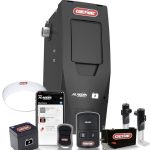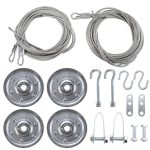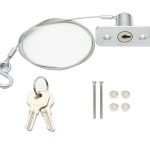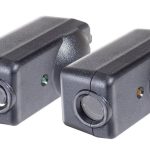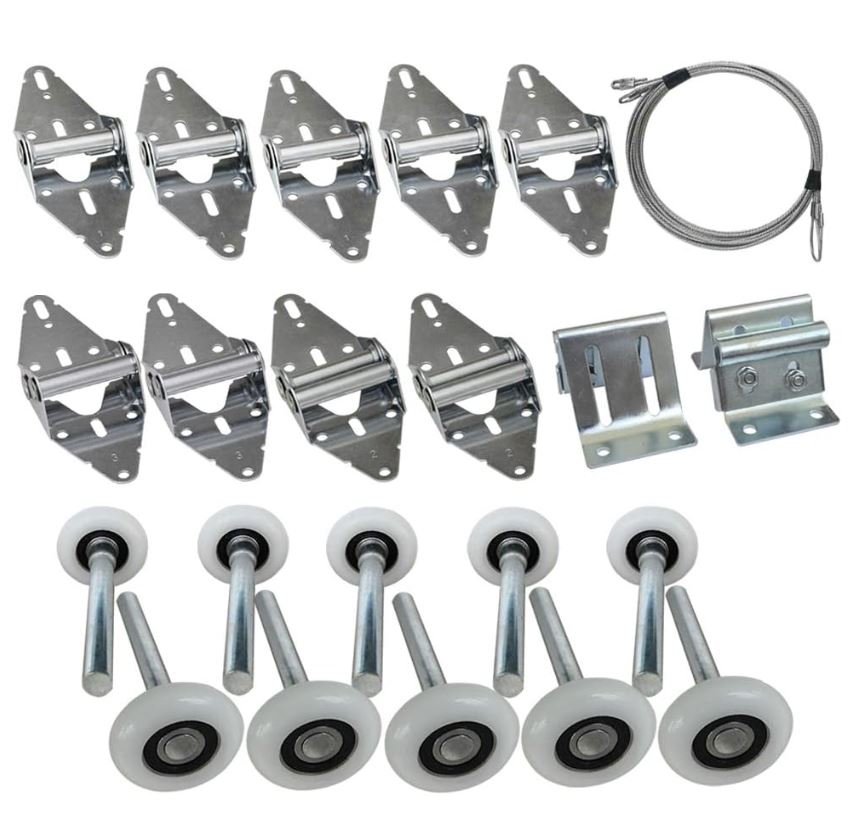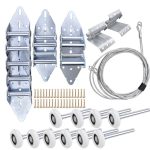What is the most common problem with garage doors?
| Type | Price Range | Technical Issues | Advantages | Disadvantages |
|---|---|---|---|---|
| Sectional Garage Door | $700 - $2,000 | Issues with springs and cables | Good insulation, quiet operation | High maintenance costs, requires space |
| Roll-Up Garage Door | $800 - $2,500 | Motor malfunctions, alignment problems | Space-saving design, durable | Limited design options, noise during operation |
| Side-Hinged Garage Door | $1,000 - $3,000 | Hinge and lock issues | Easy to operate, aesthetic appeal | Requires more clearance, manual operation |
| Slide to the Side Garage Door | $800 - $2,500 | Track alignment problems | Easy entry and exit, no overhead space needed | Potential track issues, requires side space |
| Custom Garage Door | $1,500 - $5,000+ | Varies depending on customization | Tailored to specific needs, unique design | High cost, longer installation time |
Garage Door Technical Issues
Understanding the common technical issues with garage doors can help you troubleshoot problems quickly and efficiently. Here are some frequent problems and their typical solutions.
Common Technical Problems:
- Door Not Opening or Closing: This could be due to a misaligned track, broken springs, or electrical issues with the opener.
- Noisy Operation: Squeaks or harsh noises often originate from old or un-lubricated rollers and hinges. Regular maintenance can prevent these issues.
- Door Off Track: If the door comes off its track, it's usually because of a severe impact or the tracks being worn out or bent.
- Remote Control Malfunction: Problems with the remote often stem from battery issues, distance problems, or interference with the signal.
- Automatic Reversal Malfunction: This safety feature may fail due to misaligned photo eyes or incorrect sensor settings.
How to Troubleshoot:
- Check the batteries in your remote control.
- Inspect the tracks for any visible damage or obstructions.
- Lubricate the rollers and hinges to ensure smooth operation.
- Adjust the settings on your door opener and sensors.
- Contact a professional if problems persist or you suspect broken springs or cables.
Conclusion:
While some garage door issues can be fixed with simple troubleshooting steps, others may require professional assistance. Always consider safety first and consult with a professional for complex repairs.
There are several common problems that can occur with garage doors:
The door won’t open or close: This can be caused by a variety of issues, including a broken spring, a damaged cable, or a malfunctioning opener.
The door is noisy: If your garage door is making a lot of noise when it opens or closes, it could be due to worn out rollers, hinges, or tracks.
The door is not properly balanced: If your garage door is difficult to open or close, or if it seems like it is “sticking,” it may not be properly balanced. This can be caused by a variety of issues, including a broken spring or a malfunctioning opener.
The opener is not working properly: If your garage door opener is not functioning properly, it could be due to a number of issues, including a damaged remote, a malfunctioning circuit board, or a problem with the power supply.
Door coming off track: This can be caused by improper installation, a damaged track, or a heavy load on the door.
Noisy door: This can be caused by a variety of issues, such as worn out parts or loose hardware.
Door not sealing properly: This can be caused by a variety of issues, such as a misaligned door, damaged weatherstripping, or a sagging door.
Opener not working properly: This can be caused by a variety of issues, such as a faulty motor, damaged gears, or a malfunctioning remote.
It’s important to have any issues with your garage door addressed as soon as possible, as a malfunctioning door can be a safety hazard and can also lead to further damage if not repaired.
does the price really the most important?
garage door installation diy cost
The cost of a DIY garage door installation will depend on the cost of the door and the hardware needed, as well as any additional tools or supplies you may need to purchase.
Here are some factors that can impact the cost:
- Type of door: The cost of the door itself will vary based on the material (such as wood, steel, or aluminum), style, size, and any additional features.
- Hardware: You will need to purchase hardware such as hinges, rollers, and tracks, which can add to the overall cost.
- Tools: Depending on the type of door you are installing, you may need to purchase additional tools such as a drill, level, or saw.
- Professional installation: If you choose to hire a professional to install the door, you will need to factor in the cost of labor.
It’s generally more cost-effective to hire a professional for garage door installation, as they have the experience and specialized tools needed to do the job safely and correctly.
However, if you are comfortable with DIY projects and have the necessary skills and tools, you may be able to save money by installing the door yourself.
Recent Posts
faq most common question and answers
how long garage doors last for ?
On average garage doors usually last for at least 10 to 20 years and that’s based on type of the door.
my garage door wont go up? here is why!
For most cases when the door is stuck and won’t go up its probably connected to the opener or spring, release the opener to manual, then lift the door, if its heavy so it might be the spring, just need to look if the spring is broken or not , if it broken you will have to call a professional.
why my garage door making weird noise
if you door making a loud noise you need to check for anything that looks unnormal like broken wheels or spring.
on most case the noise is just due to rusted parts and that’s easy to fix using garage lube.
programing garage remote
Essential Hardware for DIY Garage Door Kits
DIY garage door kits, selecting the right hardware is crucial for both functionality and safety.
Here’s a list of recommended hardware components:
Tracks and Brackets: These are essential for the door’s movement. Ensure they are sturdy and the correct size for your door.
Rollers: Choose high-quality rollers for smooth operation. Nylon rollers tend to be quieter than steel rollers.
Springs: Torsion springs or extension springs are vital for balancing the door. Torsion springs are generally safer and last longer but are more challenging to install.
Cables and Pulleys: These work with the springs for the lifting mechanism. Ensure they are strong enough to handle the door’s weight.
Hinges and Brackets: These connect the door panels and allow them to bend as the door opens and closes. Look for heavy-duty options for durability.
Door Opener: If you want an automatic garage door, choose a door opener that can handle the door’s weight and size.
Emergency Release Kit: This is important for safety, allowing the door to be opened manually in case of a power outage.
Weatherstripping and Insulation: To improve energy efficiency and protect against weather elements.
Safety Sensors: These prevent the door from closing if an object or person is in the way.
Locks and Security Features: For added security.
recommended power tools:
Cordless Drill: For drilling holes and driving screws. A versatile tool for various tasks in garage door installation.
Impact Driver: Useful for driving large screws and bolts, especially in tougher materials.
Circular Saw: If you need to cut any wood for framing or for the garage door itself.
Reciprocating Saw: Handy for cutting through nails or hardware, and for making any necessary adjustments to the framing.
Oscillating Multi-Tool: Useful for precision cuts and trimming, especially in tight spaces.
Torque Wrench: Essential for accurately tightening nuts and bolts to the specified torque, especially important for garage door springs and hinges.
Level: While not a power tool, a good level is crucial for ensuring the tracks and the door are perfectly aligned.
Stud Finder: If you need to secure tracks or the opener to the wall, this tool helps locate studs for a secure installation.
Air Compressor and Air Tools: If you have pneumatic tools, an air compressor can be very useful, especially for using a pneumatic nailer.
Angle Grinder: For cutting metal components or smoothing out rough edges.
Garage Door Kits for DIY Projects
Garage door kits are an excellent solution for homeowners who want to install or upgrade their garage doors by themselves.
These kits come with all the necessary components and instructions, making the process straightforward and manageable, even for those with minimal DIY experience.
Key Features of Garage Door Kits:
- Complete Package: Garage door kits include all essential parts such as panels, tracks, rollers, hinges, and hardware. Some kits also come with weather stripping and insulation materials.
- Detailed Instructions: Comprehensive step-by-step instructions are provided, ensuring you can complete the installation without professional help.
- Customizable Options: Kits are available in various styles, colors, and materials, allowing you to choose one that matches your home’s aesthetic.
- Durability: High-quality materials ensure the garage door is durable and can withstand various weather conditions.
- Safety Features: Modern garage door kits often include safety features such as pinch-resistant panels and tamper-resistant brackets.
Advantages of DIY Garage Door Kits:
- Cost-Effective: Installing a garage door yourself can save you significant labor costs.
- Sense of Accomplishment: Completing a DIY project provides a great sense of achievement and satisfaction.
- Flexibility: You can work on the project at your own pace, without the need to coordinate with a contractor’s schedule.
- Learning Experience: Installing a garage door enhances your DIY skills and knowledge.
Steps to Install a Garage Door Kit:
- Preparation: Gather all tools and materials needed. Read through the entire instruction manual to familiarize yourself with the process.
- Removing Old Door: If you are replacing an existing door, carefully remove it along with all its components.
- Installing Tracks: Assemble and install the vertical and horizontal tracks according to the instructions.
- Assembling Panels: Begin assembling the door panels from the bottom up, securing each panel before moving to the next.
- Adding Hardware: Install hinges, rollers, and other hardware as instructed. Ensure all components are securely fastened.
- Spring System: Install the torsion or extension spring system. This step might require extra caution due to the tension in the springs.
- Final Adjustments: Check the door’s balance and make any necessary adjustments. Ensure the door operates smoothly and safely.
